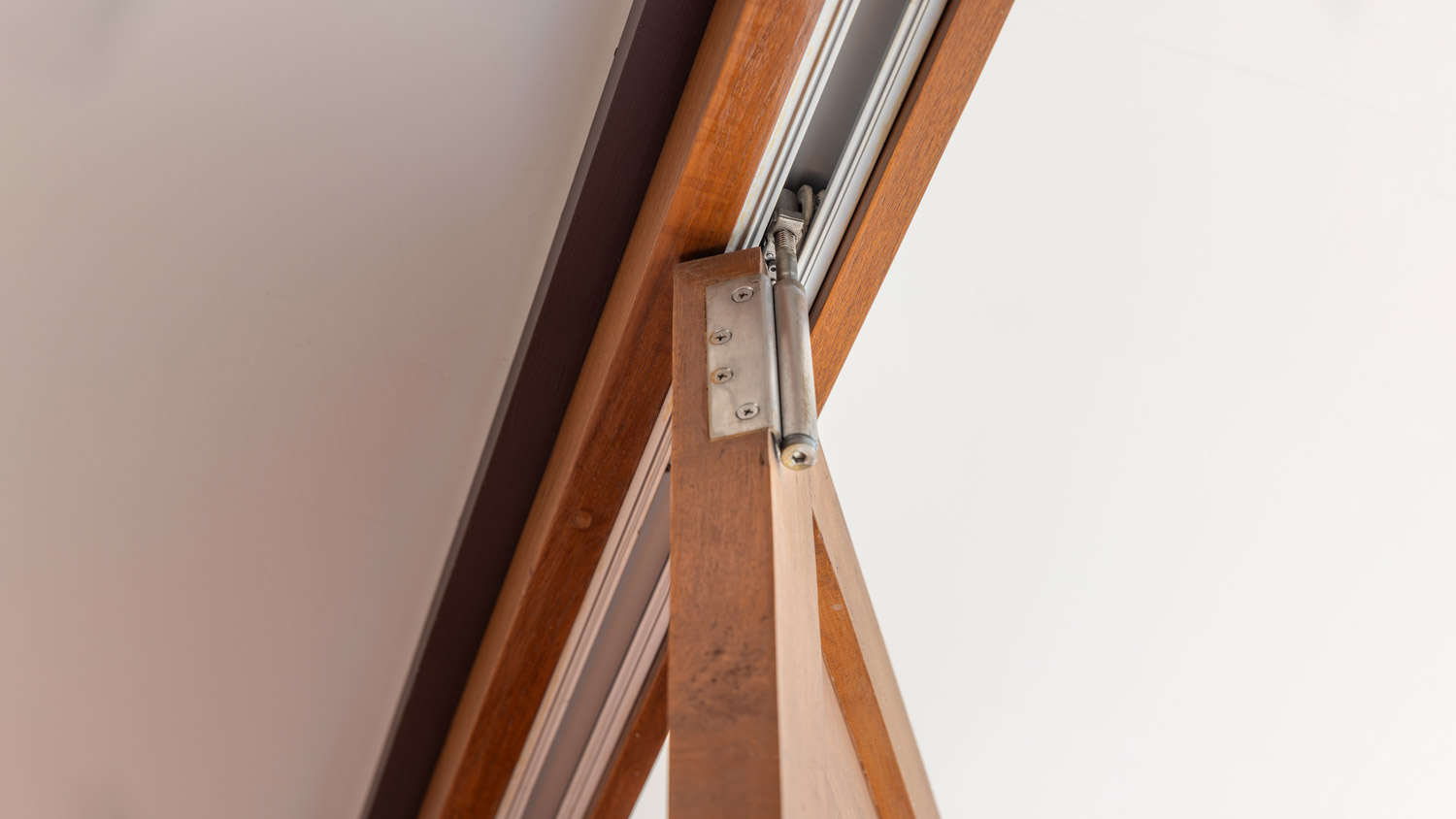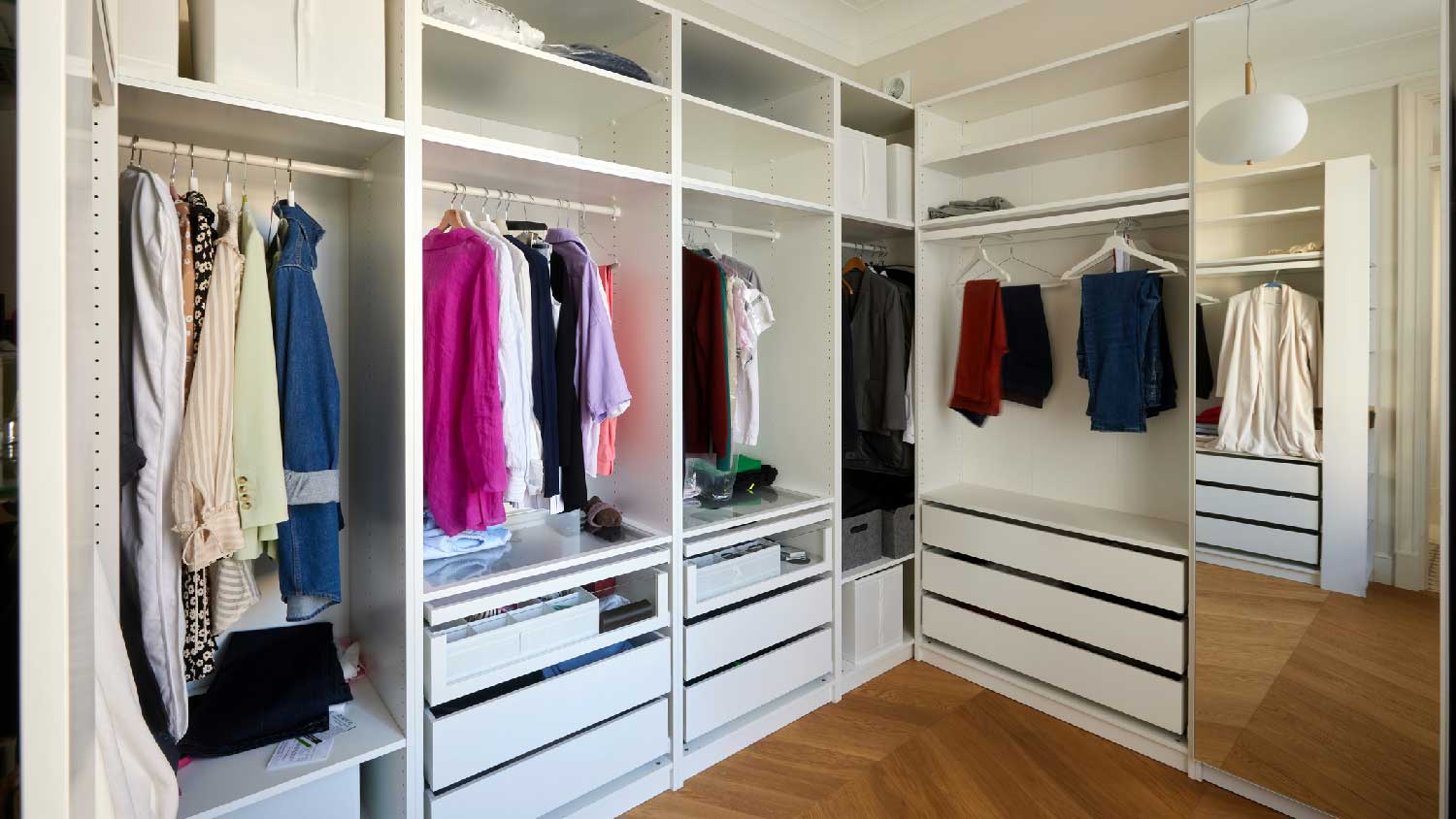
The cost of a closet remodel depends on the closet size, materials used, and the level of customization. Learn what else influences your closet remodel cost.
Adjust, align, and admire the results


Adjusting bifold doors normally costs $135 to $375 when done by a pro—and can help prevent further damage if your door frame, track, or hardware is in poor condition.
If you’re replacing the doors altogether, expect to pay $100 to $300 for installation, depending on materials and size.
If your bifold doors are off-track, sagging, or not staying closed, and you’ve already tried adjusting them, it’s smart to call a professional before parts get worse or break entirely.
A contractor has the tools and experience to quickly diagnose the problem and make precise adjustments or repairs, especially for custom or heavy doors like mirrored or wood-paneled options.
DIY adjustments are doable, but they require a screwdriver, step stool, lubricant, and cleaning supplies—plus a careful hand and solid footing when working with large, movable parts.
Bifold closet doors are a popular choice thanks to their space-saving design and easy access to closet interiors. However, like any frequently used feature, they can develop issues over time, such as sticking, misalignment, or difficulty opening and closing. Fortunately, most of these problems can be fixed with a few simple adjustments. Learn how to adjust bifold doors for closets to avoid frustrations as you dress each morning.
Bifold closet doors should operate smoothly, but when the doors are sticking, wobbling, or popping out of the track, they'll need adjusting. Regular use, humidity changes, or your house naturally settling can cause the doors to shift or sag. When the doors are misaligned, it can be difficult to open them, causing damage to the hardware or trim and unnecessary wear on the hinges and track.
There is no single method for adjusting bifold doors in your closet. The process you follow will depend on the issue you're having, and you may need to perform a few of these tricks to get your doors back in working order.
Before making any adjustments, identify exactly what's causing the issue. Common problems include doors that won't stay closed, panels that rub against each other or the frame, or hardware that's bent or loose. Open and close the doors slowly while observing how they move to pinpoint how to fix your bifold closet door based on your issue.
The top pivot bracket holds the door in place and allows it to open and close. If the door is sagging, loosen the screws on the top bracket and shift it slightly left, right, in, or out to realign the door. Once adjusted, tighten the screws to lock the bracket in place.
Similar to the top bracket, the bottom pivot bracket stabilizes the door and controls its movement. If your bifold door is leaning or not opening all the way, adjusting this bracket can correct its vertical or lateral positioning. Loosen the screws just enough to shift the bracket slightly, then retighten once you find the right alignment.
If the door is dragging on the floor or there’s an uneven gap at the top, you may need to raise or lower the door height. You can do this by turning the height adjustment screw or nut located on the top or bottom pivot pin. Turning it clockwise raises the door, while turning it counterclockwise lowers it.
Misaligned panels can prevent the doors from closing flush or make them look uneven. Loosen the screws that hold the door hinges and shift the panels slightly so they line up evenly from top to bottom. Re-tighten the screws once they’re properly aligned. You may need an extra set of hands to help you find the right alignment.
Dust, dirt, and debris in the upper and lower tracks can interfere with how the door slides and pivots. Use a vacuum with a nozzle attachment or a damp cloth to clean the track thoroughly. If there's stubborn buildup, a mild cleaner or degreaser can help.
If the doors are squeaky or hard to slide, lubricate the moving parts. Use a silicone-based spray or a light household lubricant on the pivot pins, track, and any sliding components. Avoid using heavy oils, which can attract dust.
Sometimes adjustments and maintenance aren’t enough, especially if the hardware is bent, stripped, or broken. If parts like pivot pins, brackets, or rollers are visibly worn or damaged, it’s best to replace them. Most bifold door hardware is inexpensive and available at hardware stores. Swapping in new parts can restore the door's functionality and save you from future issues.

With just a little regular maintenance, you can prevent annoying issues like squeaking, sticking, or misalignment. Here are some simple tips to keep your bifold closet doors in great shape:
Clean the track regularly: Use a vacuum or soft brush to remove dust and debris from the top and bottom tracks.
Wipe down the doors: Clean the panels with a damp cloth and mild soap to prevent dirt buildup or staining.
Lubricate moving parts: To keep the doors sliding smoothly, apply a silicone-based lubricant to the pivot pins and tracks every few months.
Check hardware for tightness: Periodically inspect screws, brackets, and hinges and tighten anything that has become loose over time.
Avoid slamming the doors: Gently opening and closing the doors can prevent stress on the pivots and brackets.
Inspect for wear and tear: Look for signs of rust, warped panels, or worn-out hardware and replace parts as needed.
Keep humidity in check: Excess moisture can cause wood doors to swell or warp, so try to maintain stable indoor humidity levels with a dehumidifier.
Don’t hang heavy items: Avoid placing heavy items on or over the doors. This can affect balance and strain the hardware.
Adjusting bifold closet doors is a DIY project most homeowners can handle with basic tools like a screwdriver and a step stool. If the doors are slightly misaligned, dragging, or not closing properly, adjustments to the pivot brackets, height, or panel alignment are quick fixes. Cleaning the track and lubricating the hardware are also simple maintenance tasks that don’t require professional help.
However, it may be worth calling in a local closet maker if the door frame is damaged, the track is severely bent or broken, or if you've attempted multiple adjustments without success. If your bifold doors are custom-sized, part of a larger closet renovation, or closet door alternatives made from heavy materials like mirrored glass or solid wood, professional installation or repair can ensure everything is properly aligned and safe to use. When hiring a pro, the average door repair cost ranges between $135 and $375, depending on the type of closet door you have.
From average costs to expert advice, get all the answers you need to get your job done.

The cost of a closet remodel depends on the closet size, materials used, and the level of customization. Learn what else influences your closet remodel cost.

Discover the cost to hire a professional closet organizer, including average prices, cost factors, and tips to help you budget and maximize your investment.

Discover the average custom closet cost, including price ranges and key factors, to help you budget and plan your project with confidence.

Understanding the average days for a closet remodel helps you prepare for a smooth renovation. Here's what you need to know about the timeline.

A well-crafted closet can instantly make your mornings more enjoyable. Learn how to design a closet that blends functionality with style.

Knowing how to frame a closet is the first step to building your own. With the right tools and DIY experience, you can do a project like this in one afternoon.